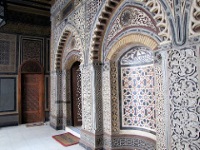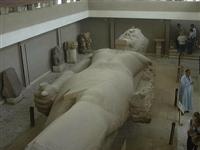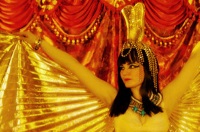
The Egyptians were the first people to develop the art technology to manufacture glass and cut it into beautiful shapes. This ancient civilisation started making crystals 5,000 years ago. Asfour Crystal was established in 1961 and the Asfour Crystal Factory Showroom is one of the largest and most respected crystal factories in Egypt and provides crystals to many countries across the globe. They are said to be the world's single largest employer of skilled crystal workers. Products range from jewellery to 3D laser gifts, figurines and a selection of chandeliers and other light fittings. The jewellery is not quite of the same standard as Swarovski crystal but some lovely pieces can be picked up at the factory at prices up to 60 percent cheaper than what you'll find at retail shops, and there are some beautiful, creative pieces on show. Asfour Crystal is most famous for their crystal chandeliers and there is a vast array to choose from. The hundreds of shining lights and glittering crystals in the showroom make it a magical space, worth seeing even if you don't purchase anything. There is also a small display detailing the manufacturing process, and helpful and knowledgeable sales staff available to help. A tax certificate is given with all purchases.
Address : Industrial Zone: 5 Asfour Crystal, St. Shoubra Al Kheima.
Website : www.asfourcrystal.com
Telephone : (0)2 4220 1032

The only round, or domed, church left in Cairo, the Greek Church of St George features a long set of steps that lead up to the church, where visitors will find a relief of St George and the dragon wrapped around the outer brickwork of the tower. The original church dated back to the 10th century, or earlier, but this ancient structure largely burned down and the current church replaced it in 1904. For centuries, the church alternated between Coptic and Greek ownership, but since the 15th century it has remained Greek Orthodox, and the adjoining monastery of St George is now the seat of the Greek patriarch. Despite this, the Moulid of Mari Girgis, a large Coptic festival celebrating St George, is celebrated at the church each April.The St George Church is most famous for its beautiful wedding hall ( Qaat el Irsan), which dates back to the 14th century. St George was a warrior saint imprisoned and martyred near the church, which is built on an ancient Roman tower. Sadly, this wonderful building is often not included in tours of Coptic Cairo but it is well worth the visit and very easy to find. The church and monastery are visible from Mari Girgis Station.
Address : Mari Girgis Street, Old Cairo
One of the most worthwhile things to see and do in the Cairo area is take an excursion to Dahshur, a royal necropolis in the desert, where the oldest true pyramid, the Red Pyramid, can be found. Some of the burial sites and pyramids date back to the Old Kingdom of the 4th dynasty and the Red Pyramid and the Bent Pyramid were built by Sneferu in about 2600 BC. The Bent Pyramid is so-called because the angle of its sides is not quite straight, probably the result of an ancient engineering mistake. The Red Pyramid, made out of red limestone, was built after the Bent Pyramid and is thought to have been the first true, straight-sided pyramid in Egypt. The famous Pyramids of Giza were modelled on this design. You can usually climb into the Red Pyramid and descend down a tunnelled ramp into its three interior chambers which is a rare privilege. There are other tombs of interest scattered around the area and you can't walk far without stumbling on some wondrous ancient ruin.Dahshur is about 20 miles (32km) from Cairo and makes for a fascinating excursion from the city. The drive takes under an hour and follows a scenic route which passes through date orchards. Dahshur is far less crowded than most other big tourist attractions and visitors experience far less of the hassle from locals and touts that they do at Giza. At this site you can still get the thrill of an explorer discovering something mysterious and ancient.However, the empty nature of this famous archaeological site is partly due to occasional sectarian violence in the nearby town of Dahshur, so travellers are advised to check out travel alerts to gauge how safe it is before they visit.

With over 100,000 artefacts in 107 halls, the Egyptian Museum provides days of exploration. Inside are treasures from ancient Egypt, including priceless finery taken from ancient royal tombs, and one of the museum's masterpieces, the statue of Khafre (Chephren). The most popular attraction is the Tutankhamun Gallery where exquisite treasures from the tomb of the iconic Boy King are displayed, including the famous solid gold death mask. Another top attraction is the Royal Mummy Room containing mummies of some of the most powerful Pharaohs in Egypt dating from the 18th to 20th dynasties (there is an additional cost for this room). The museum also contains collections of artefacts including coins, papyrus scrolls, scarabs and sarcophagi. There is a cafeteria, bank, post office, gift shop and library at the museum and taped audio guides are available in English, French and Arabic. Visitors should be aware that photography is not allowed.Although a trip to Egypt would feel incomplete without a visit to this incredible museum, its location on Tahrir Square means that foreigners must be cautious visiting during periods of unrest. If there are demonstrations on the square it is best to avoid the area.
Address : Mariette Pasha Street, Tahrir Square
Website : www.sca-egypt.org/eng/MUS_Egyptian_Museum.htm
Telephone : (02) 5794596
Opening times : Open daily 9am to 7pm (9am to 5pm during Ramadan)
Admission : General admission for foreigners is EGP 60. Concessions are available.

The Hanging Church in Cairo derives its name from its location on top of the southern tower gate of the old Babylon fortress, with its nave suspended over a passage. It is the most famous Coptic church in Cairo with the earliest mention of the church being a statement in the biography of the patriarch Joseph, who lived in the mid-19th century. It went on to become known to travellers as the 'staircase church' during the 14th and 15th centuries, because of the twenty-nine steps that lead to the entrance.The visual impact of the church's elevated position has been reduced due to the rise of land surface by around 20 feet (six metres) since the Roman period, not to mention the rise of tall buildings around it, but it is still an impressive and beautiful church. The Roman tower upon which it is built remains mostly buried below ground. It is calm and peaceful inside and visitors are not pestered here as they may be at many other Cairo attractions. Among the highlights of the church are the intricate carvings and mosaics which decorate the walls, windows and doors.
Address : Shara Mari Girgis Street, Old Cairo

Buzzing with enthusiastic buying and selling, Khan al-Khalili is one of the largest markets in the world. Situated within Islamic Cairo, the World Heritage Site attracts travellers and locals alike. On the northern corner of the bazaar is the Mosque of Sayyidna al-Hussein, one of the holiest Islamic sites in Egypt. The market is the best place to soak up the colour of Cairo and to people-watch and the streets themselves are charming with arches, carvings and mosaics. You will get many amazing photo opportunities wandering the labyrinthine little streets, just be sure not to get lost!Traders have been bargaining in these alleys since the 14th century and it is possible to buy almost anything, from exotic perfume bottles to everyday Arabic clothing. There is, of course, a lot of junk as well but treasures and great bargains can be found. Be prepared to barter as the prices originally stated will always be much too high and the merchants expect you to negotiate. Although some of the traders are delightful others can get pushy and rude. Unfortunately, women travelling alone will almost certainly have to put up with a certain amount of harassment. No matter how many times you visit this vibrant market you will always find something new and enchanting, just keep a careful eye on your wallet.

This indoor amusement park spans two floors and features a handful of big rides, more than 100 games, and even a Baby Zone section for very young visitors. Kids can enjoy rides such as the Moon Buggy or Falling Star, and family rides like the Comet Coaster and Demolition Derby. They can spend hours ensconced in games and fun activities, or even let off some steam in the Soft Play Room. This is a fantastic attraction for the whole family, and a great way to beat the Egyptian heat for a while, or take a break from historical sightseeing. The focus of the amusement park is on children aged between two and 12 but there is fun to be had for all age groups.Upon entry you will get a Magic Galaxy Card which is prepaid for use of games and rides and can be recharged with fresh funds whenever needed. The cards also accumulate points from certain games and you can pick prizes according to how well you have done. If you happen to go on your birthday you'll get a whole bunch of nifty discounts.
Address : 4th & 5th floor Helioplis City Stars Centre, Omar abn El khatab Street
Website : www.magicgalaxy.net
Telephone : (0)2 230 545 75

Memphis and Saqqara are small towns today, but in ancient Egypt they were great cities and seats of power, a legacy still traceable in the ruins and relics in each. Memphis is home to the Temple of Ptah, which includes the Colossus of Ramses II, a 33-foot (10m) statue near the entrance, and a small museum. Memphis was once the capital of Egypt and you can still tell how impressive it once was.Less than two miles (3km) away is the plateau of Saqqara. Here visitors will find the vast Saqqara Necropolis, containing many cemeteries, pyramids, mastabas and private tombs, including the Mastaba of Ti, the Pyramid of Teti I, and the Unas Causeway and Pyramid of Unas. One of the most famous structures in Saqqara is the Step Pyramid of Djoser, also known as the Step Tomb due to its rectangular base. Saqqara is also home to the Imhotep Museum.Memphis and Saqqara together make a popular excursion from Cairo. There isn't much in the way of entertainment, dining, or accommodation at these sites, however, so most visitors don't overnight.

Once known as the Roman stronghold of Babylon, Coptic Cairo is the oldest part of the city and the heart of the Coptic Christian community. Home to 5 original churches alongside Egypts first mosque and oldest synagogue, these ancient walls house three of the major religions of the modern world in one special area. It is a peaceful place to wander around and a respite from the busy city centre.Churches of interest are the Al-Muallaqa (Hanging Church), the oldest Christian place of worship in the city, and St Sergius where the Holy Family reputedly sheltered during their flight to Egypt. You can take the metro into Coptic Cairo from Tahrir Square. It is useful to have a guide when exploring the area as there is so much history to discover and so much to see. However, visitors who chose to explore alone will feel the power and age of the place and should still be able to find all the major attractions.

The pyramids are the earth's oldest tourist attraction and the Great Pyramid of Khufu (also referred to as the Great Pyramid of Cheops) is the only remainder of the seven ancient wonders of the world. Throughout history the pyramids have fired human imagination, with much speculation as to their origin and purpose. The most compelling theory is that they were built by the ancient Egyptian civilisation as tombs or great monuments in which to bury their kings and nobles; a place to start their mystic journey to the afterlife.The oldest and largest pyramid, the Great Pyramid, is thought to have taken 20 years to build and is made of about two million blocks of limestone. No one knows how the two-ton blocks were moved into place, but it was known to be the tallest man-made structure in the world for over 40 centuries. The Great Sphinx, known as the Abu al-Hol (Father of Terror), stands in front of the Great Pyramid and is thought to be older than the pyramids themselves.Tours of the pyramids are conducted by many tour operators in Giza. Access to the interior of the pyramids is restricted, and at least one is closed for renovations at any given period. While climbing the pyramids was once a popular activity, the practise has now been banned. The best time to visit the Pyramids of Giza is early in the morning, before the tour buses descend on them. While unofficial 'tour guides' lurk around the site to demand tips, better-informed guides can be booked in advance from Giza. It is often best to ask your hotel's advice on guides.
Address : Pyramid Road, 11 miles (18km) southwest of the centre
Website : www.sca-egypt.org/eng/SITE_GIZA_MP.htm
Transport : Bus 8 from Midan Tahrir

Discovered in 1882 during excavations, the giant statue of Pharaoh Ramses II was cut into six pieces in the 1950s and moved to Ramses Square in central Cairo where it stood for a further 50 years. In 2006 the statue moved to a new, temporary museum a few miles outside of Cairo, as there were growing concerns that heavy pollution was damaging the 3,200-year-old statue, which weighs 83 ton and stands 36 feet (11 metres) high. The moving of the massive statue was a technological challenge and has been covered in a documentary by National Geographic.Ramses II, who ruled Egypt for more than 60 years during the 19th dynasty of pharaohs, was one of ancient Egypt's most prolific builders and there are a number of statues of him remaining in Egypt. However, none are as impressive as the colossus. All in all, the statue is beautifully preserved although one side is discernibly less perfect as it was exposed to the elements for centuries before its re-discovery in 1882. The expression on his face is serene and quite enthralling.The famous statue was moved for the final time in January 2018. It now takes pride of place in the entrance hall of the Grand Egyptian Museum. This 650,000-square-foot museum is currently under construction and will have capacity for up to 100,000 artefacts upon completion in 2020.

The Saladin Citadel is a massive stone fortress, set in a beautiful tropical location, built by Salah ad-Din in the 12th century. Visitors have the freedom to roam the castle, which remains in pristine condition, and which boasts incredible views of Cairo. If you are lucky enough to visit on a clear day you will be able to see all the way to the pyramids. The execution room is particularly interesting but just wandering around this ancient citadel is fascinating. The Mohammed Ali Mosque (also called the Alabaster Mosque) crowns the citadel and this magnificent place of worship is the highlight of the fortress. It was built between 1824 and 1857 and modelled on the famous Blue Mosque in Istanbul. There are two other mosques within the Citadel: the 13th-century Mosque of al-Nasir Muhammad, and the 16th-century Mosque of Suleyman Pasha. As always, women visiting the mosques must wear loose clothing and be prepared to cover up (there are scarves available at the entrance for this purpose if you do not bring your own). The Al-Gawhara Palace, National Military Museum and Police Museum can also be found inside the Citadel.
Address : al-Qalaa, Shara Salih Salem

This living museum is a fabulous attraction for the whole family to enjoy. Visitors sail down a network of canals in motorized barges where a cast of actors and actresses work to recreate ancient Egypt. All the characters from pharaohs and fishermen to slaves and potters are represented and even moments in history are recreated. Apart from the faithful reproductions of ancient Egyptian buildings, clothing and lifestyles, there is a complete replica of the tomb of Tutankhamen and a number of museums and interactive exhibits covering different periods of Egypt's history.Exhibits and activities change regularly making it a different experience every time you visit, but favourites include the mummification exhibit and the Cleopatra exhibit. There is a small amusement park, a restaurant, shops and an art centre, as well as boat hiring facilities. The experience is fun and educational and will take a family at least a few hours to fully appreciate so be sure to allow sufficient time.
Address : 3 El Bahr El Aazam St, Cairo.
Website : www.pharaonicvillage.com
Telephone : (0)2 3571 8675
Opening times : 9am to 5pm daily. Open until 7pm in the peak summer months.
Admission : Fees vary on itinerary selected.

From Cairo it is possible to experience Egypt's finest journey on offer, the Great Desert Circuit. It runs for over 621 miles (1,000km) through spectacular desert landscapes and is punctuated by four oases situated in a depression: Bahariya, Farafra, Dakhla and Kharga. The first two have hot springs and palm groves, Farafra being the more traditional and rural of the two.To experience the remoteness of the desert travellers can spend an unforgettable night in the White Desert between oases. Dakhla and Kharga are surrounded by old ruins and villages from the times of the ancient caravan routes to Sudan. The Great Desert Circuit is a fascinating journey and really allows travellers to grasp the enormity of the Egyptian desert and appreciate the history of exploration in the region. The roads are in good condition, with hardly any traffic on them, and the whole circuit can be done in anything between 16 hours and a week (you can linger as you please). Some of the oasis towns are lovely places to spend a night before setting off on your road trip again.
Transport : The circuit takes between a day and a week depending on desired schedule and can be travelled using public or one’s own transport, or visitors can book a tour. It is also possible to hire a local guide with a 4x4.

Travel Guide powered by Word Travels, copyright © 2023 Globe Media Ltd. By its very nature information in this travel guide is subject to change at short notice and travellers are urged to verify information on which they're relying with the relevant authorities. Neither Globe Media Ltd nor Travel Vogue can accept any responsibility for any loss or inconvenience to any person as a result of information contained above.